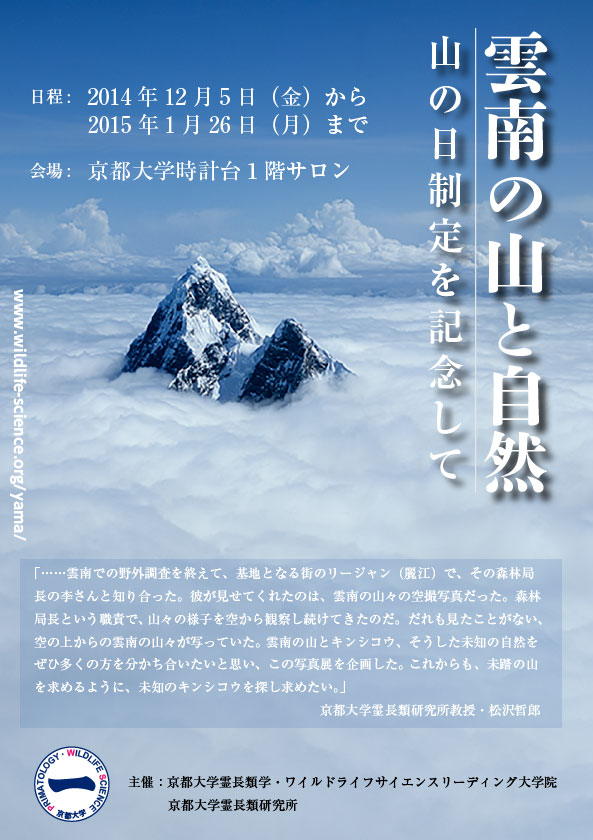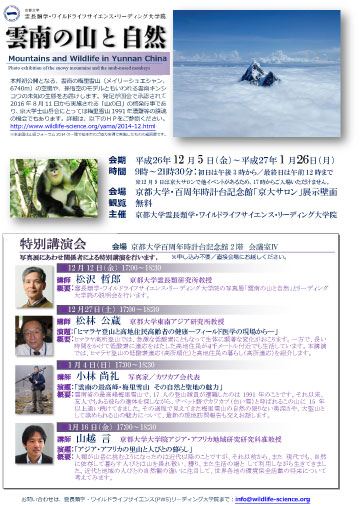
Mountains and Wildlife in Yunnan China
Photo exhibition of the snowy mountains and the snub-nosed monkeys
云南之山与自然
日本特别定制的山之纪念 中国云南之山与野生动物
雪山与金丝猴照片展
2015年01月26日(月)まで
(初日は午後3時から/最終日は午前12時まで)
※12月9日は京大サロンで他イベントがあるため、17時からご入場いただけません。ご了承ください。
12月9日在京都大学沙龙还有其他的活动,17点开始敬请光临
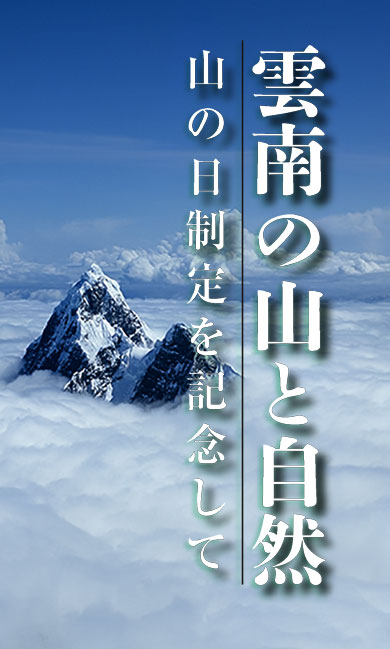
Presented by
Leading Graduate Program
in Primatology and Wildlife Science(PWS), Kyoto University
https://pws.wrc.kyoto-u.ac.jp/index.html
京都大学霊長類研究所
Primate Research Institute, Kyoto University
http://www.pri.kyoto-u.ac.jp/index-j.html
京都大学灵长类研究所
在京都会场的纪念活动
2014/12/12 17:00-18:30
会場:京都大学百周年時計台記念館2階 会議室Ⅳ
December 12th 17:00-18:30 / Conference Room IV of Clock Tower Centennial Hall, Yoshida Campus of Kyoto University2014年12月12日17:00-18:30 / 会场:京都大学百年钟楼纪念馆2楼第Ⅳ会议室
写真展「雲南の山と自然 -山の日制定を記念して-」京都会場での開催を記念して、12月12日に、松沢哲郎先生(京都大学霊長類研究所教授)による、 霊長類学・ワイルドライフサイエンス・リーディング大学院の写真展「雲南の山と自然」とリーディング大学院の説明会を行います。
Photo Exhibition Mountains and Nature in Yunnan - Special Day of Mountains On Dec. 12th Prof. Tetsuro Matsuzawa (Prof. of Primate Research Institute, Kyoto University) will be present at the opening ceremony for the photo exhibition of Mountains and Wildlife in Yunnan China - the snowy mountains and the snub-nosed monkeys organized by Leading Graduate Program in Primatology and Wildlife Science (PWS) and the explanation session for the PWS.
作为“云南之山与自然— 山之日特别纪念”照片展京都会场的纪念活动,12月12日松泽哲郎先生(京都大学灵长类研究所教授)将出席灵长类学・野生动物科学・先导研究生院的“云南之山与自然”照片展与先导研究生院说明会。

1950年10月15日生まれ。京都大学霊長類研究所教授、理学博士。兼職として、公益財団法人日本モンキーセンター所長、国際霊長類学会長、全国山の日協議会副会長。紫綬褒章受章、文化功労者。主著に、『想像するちから』(岩波書店)ほか。
Tetsuro Matsuzawa
Born on Oct. 15th 1950. Professor of Primate Research Institute, Kyoto University, Dr. of Science Serving Concurrently as Director of Public Corporation - Japan Monkey Centre, Chairman of International Primate Academic Association, National Deputy Mountain Japanese Committee. Purple ribbon winner, Culture ambassador. Major works The Power of Imagination (Iwanami Shoten) etc.
松泽哲郎
1950年10月15日生 京都大学灵长类研究所教授 理学博士 兼职公益财团法人日本猿猴中心所长、 国际灵长类学会会长、全国山岳日协会副会长、 紫色缎带奖章得主、文化功劳者、主要著作《想象的力量》(岩波出版社)等
キンシコウ:孫悟空のモデルになったサル
雲南省でキンシコウの調査を始めています。キンシコウというのは孫悟空のモデルになったサルです。霊長類(サルのなかま)で最も高いところにすむものが、雲南キンシコウです。そのさらに西の梅里雪山の山稜のどこかには、未知の梅里キンシコウがいるかもしれません。 雲南の山とサルについて最新の成果をお話します。
Snub-nosed monkeys:Prototype of Monkey King
I started the research on snub-nosed monkeys in Yunnan, China. The so-called snub-nosed monkeys are the prototypical monkeys of the image of Monkey King. Among Primates (Monkey’s close pals), who live in the highest place, they are known as Yunnan snub-nosed monkeys. Moreover, in the mountains west to Meli Snow Mountain, there might be an unknown species, Meili snub-nose monkey. I am going to talk about the newest research findings concerning snowy mountains and monkeys in Yunnan, China.
我开始了在云南研究金丝猴的课题。孙悟空就是以金丝猴为原型而创造出来的文学形象。在灵长类(猴子的伙伴)中,生活在海拔最高处的是滇金丝猴。再者,梅里雪山以西的山峦中,也许还有梅里金丝猴。我要讲的是云南的山和猴子的最新研究成果。
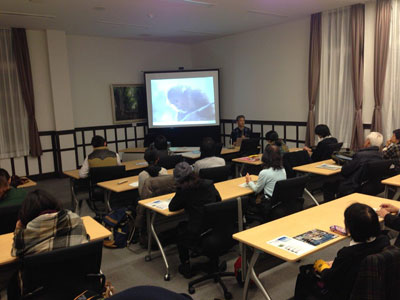
2014/12/27 17:00-18:30
会場:京都大学百周年時計台記念館2階 会議室Ⅳ
December 27th 17:00-18:30 / Conference Room IV of Clock Tower Centennial Hall, Yoshida Campus of Kyoto University2014年12月27日17:00-18:30 / 会场:京都大学百年钟楼纪念馆2楼第Ⅳ会议室
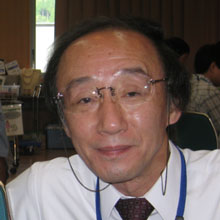
東南アジア研究所・教授
Kozo MATSUBAYASHI
Professor, Center for Southeast Asian Studies Kyoto University
ヒマラヤ登山と高地住民高齢者の健康ーフィールド医学の現場からー
ヒマラヤ高所登山では、急激な低酸素にともなって生体に顕著な変化がおこります。一方で、長い時間をかけて低酸素に適応をはたした高地住民が4千メートル付近でも生活しています。本講演では、ヒマラヤ登山の低酸素適応(高所順化)と高地住民の暮らし(高所適応)を紹介します。
Report from the site of field medicine on health of Himalaya mountain climbers and highland dwelling senior citizens
During the process of mountain climbing at Himalaya Plateau, it is obvious that the body will experience a sudden and rapid drop of oxygen. Over long periods of time, plateau dwellers have adapted to the low oxygen environment and live at highlands close to 4000 meters above sea level. The talk is about Himalaya mountain climbers' adaptation to hypoxia (acclimatization) and highland citizens’ life (high altitude adaptationn)
从田野医学现场看喜马拉雅登山和高原住民高龄者的健康
在喜马拉雅登山身体显著变化就是急剧缺氧。经久历时,高原住民已经适应了缺氧,生活在海拔4000米左右附近的高原。本演讲要讲述的是喜马拉雅登山缺氧适应(高原水土适应)与高原住民生活(高原生活适应)。
2015/01/04 17:00-18:30
会場:京都大学百周年時計台記念館2階 会議室Ⅳ
January 4th 17:00-18:30 / Conference Room IV of Clock Tower Centennial Hall, Yoshida Campus of Kyoto University2015年1月4日17:00-18:30 / 会场:京都大学百年钟楼纪念馆2楼第Ⅳ会议室
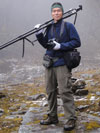
写真家/カワカブ会代表
http://www.k2.dion.ne.jp/~bako/
Naoyuki Kobayashi
Photographer/Representative of Kawagebo Committee
摄影师/卡瓦格博峰协会代表
雲南の最高峰・梅里雪山 その自然と聖地の魅力
雲南省の最高峰梅里雪山で、17人の登山隊員が遭難したのは1991年のことです。それ以来、友人でもある彼らの遺体を探しながら、チベット語でカワカブ(白い雪)と呼ばれるこの山に15年以上通い続けてきました。その過程で見えてきた梅里雪山の自然の限りない奥深さや、大聖山として崇められる山の魅力について、最新の現地訪問報告も交えながらお話します。
The highest peak in Yunnan・Meili Snow Mountain The Charm of nature and the holy land
It was in 1991 people searched for the remains of 17 mountain climbers of the mountain accident. Friends’ efforts of searching their bodies have been lasting in Meili Snow Mountain which was known as Kawakabo (White Snow in Tibetan) for more than 15 years. I will talk about the endless profoundness, the charm of the grand and admirable great holy mountain I witnessed during the process of searching for the deceased, and the latest local interviews.
云南最高峰・梅里雪山以及梅里雪山圣地的魅力
在云南省有17位登山队员遭遇山难是1991年的事情了,从那时起,朋友们在卡瓦格博峰(藏语名为白雪)的山上不断地寻找他们的遗体也超过15个年头了。我想谈谈在此期间我所见的梅里雪山无限深邃的自然,作为大圣山被人崇敬的山之魅力,以及最新参与的当地访谈。
2015/01/16 17:00-18:30
会場:京都大学百周年時計台記念館2階 会議室Ⅳ
January 16th 17:00-18:30 / Conference Room IV of Clock Tower Centennial Hall, Yoshida Campus of Kyoto University2015年1月16日17:00-18:30 / 会场:京都大学百年钟楼纪念馆2楼第Ⅳ会议室

京都大学大学院アジア・アフリカ地域研究研究科・准教授
Gen Yamakoshi
Graduate School of Asian and African Area Studies, Kyoto University・Assistant Professor (Graduated from Matsumoto Fukashi Normal University) 京都大学 研究生院亚洲・非洲区域研究研究科 副教授
アジア・アフリカの里山と人びとの暮らし
人類が山岳に挑むようになったのは近代以降のことですが、それ以前から、また 現代でも、自然に依存して暮らす人びとは山を畏れ敬い、護り、また生活の場と して利用しながら生きてきました。近代と地域の人びとの自然観の違いに注目して、世界各地の環境保全活動の将来について考えてみます。
Life in the depth of Asian and African mountains
Not until contemporary era did human beings start the endeavor to challenge mountains. Nevertheless, before then and also now, for those whose lives are indispensible with mountains and nature, awe dwells within. Simultaneously in daily life, people protect and make use of mountains and nature. Focusing on the nature ideology that differs from area to area in contemporary era, I think about the future of environmental conservation all over the world.
住在亚洲与非洲深山里的人们的生活
人们直到近代才开始挑战山岳,在此之前,哪怕是现在,依存于山的人们对山峦和自然抱有敬畏之心,同时,人们保护、利用山与自然生存下来。我关注近代和不同地区人们自然观的差异,尝试思考世界各地环境保护的未来。
